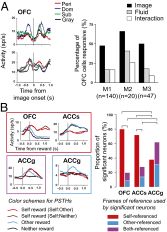Neuroethology of primate social behavior
- PMID: 23754410
- PMCID: PMC3690617
- DOI: 10.1073/pnas.1301213110
Neuroethology of primate social behavior
Abstract
A neuroethological approach to human and nonhuman primate behavior and cognition predicts biological specializations for social life. Evidence reviewed here indicates that ancestral mechanisms are often duplicated, repurposed, and differentially regulated to support social behavior. Focusing on recent research from nonhuman primates, we describe how the primate brain might implement social functions by coopting and extending preexisting mechanisms that previously supported nonsocial functions. This approach reveals that highly specialized mechanisms have evolved to decipher the immediate social context, and parallel circuits have evolved to translate social perceptual signals and nonsocial perceptual signals into partially integrated social and nonsocial motivational signals, which together inform general-purpose mechanisms that command behavior. Differences in social behavior between species, as well as between individuals within a species, result in part from neuromodulatory regulation of these neural circuits, which itself appears to be under partial genetic control. Ultimately, intraspecific variation in social behavior has differential fitness consequences, providing fundamental building blocks of natural selection. Our review suggests that the neuroethological approach to primate behavior may provide unique insights into human psychopathology.
Keywords: decision; evolution; oxytocin; reward; serotonin.
Conflict of interest statement
The authors declare no conflict of interest.
Figures




Similar articles
-
Coevolutionary relationship between striatum size and social play in nonhuman primates.Am J Primatol. 2011 Apr;73(4):314-22. doi: 10.1002/ajp.20898. Epub 2010 Nov 8. Am J Primatol. 2011. PMID: 21328590
-
Adaptations for social cognition in the primate brain.Philos Trans R Soc Lond B Biol Sci. 2016 Feb 5;371(1687):20150096. doi: 10.1098/rstb.2015.0096. Philos Trans R Soc Lond B Biol Sci. 2016. PMID: 26729935 Free PMC article. Review.
-
Social components of fitness in primate groups.Science. 2007 Sep 7;317(5843):1347-51. doi: 10.1126/science.1140734. Science. 2007. PMID: 17823344 Review.
-
Social relationships and social cognition in nonhuman primates.Science. 1986 Dec 12;234(4782):1361-6. doi: 10.1126/science.3538419. Science. 1986. PMID: 3538419 Review.
-
Genes, hormones, and circuits: an integrative approach to study the evolution of social behavior.Front Neuroendocrinol. 2011 Aug;32(3):320-35. doi: 10.1016/j.yfrne.2010.12.004. Epub 2010 Dec 14. Front Neuroendocrinol. 2011. PMID: 21163292 Review.
Cited by
-
Epigenomics and gene regulation in mammalian social systems.Curr Zool. 2020 Jun;66(3):307-319. doi: 10.1093/cz/zoaa005. Epub 2020 Feb 25. Curr Zool. 2020. PMID: 32440291 Free PMC article.
-
The neuroethology of friendship.Ann N Y Acad Sci. 2014 May;1316(1):1-17. doi: 10.1111/nyas.12315. Epub 2013 Dec 11. Ann N Y Acad Sci. 2014. PMID: 24329760 Free PMC article. Review.
-
Neural bases of social facilitation and inhibition: how peer presence affects elementary eye movements.Soc Cogn Affect Neurosci. 2025 Jun 17;20(1):nsae079. doi: 10.1093/scan/nsae079. Soc Cogn Affect Neurosci. 2025. PMID: 39506559 Free PMC article.
-
Superior pattern processing is the essence of the evolved human brain.Front Neurosci. 2014 Aug 22;8:265. doi: 10.3389/fnins.2014.00265. eCollection 2014. Front Neurosci. 2014. PMID: 25202234 Free PMC article. Review.
-
Oxytocin response to youth-mother interactions in clinically anxious youth is associated with separation anxiety and dyadic behavior.Depress Anxiety. 2017 Feb;34(2):127-136. doi: 10.1002/da.22585. Epub 2017 Jan 3. Depress Anxiety. 2017. PMID: 28052452 Free PMC article.
References
-
- Berkman LF. Social support, social networks, social cohesion and health. Soc Work Health Care. 2000;31(2):3–14. - PubMed
-
- Cohen S. Social relationships and health. Am Psychol. 2004;59(8):676–684. - PubMed
-
- Barefoot JC, Grønbaek M, Jensen G, Schnohr P, Prescott E. Social network diversity and risks of ischemic heart disease and total mortality: Findings from the Copenhagen City Heart Study. Am J Epidemiol. 2005;161(10):960–967. - PubMed
-
- Baron RA, Markman GD. Beyond social capital: The role of entrepreneurs' social competence in their financial success. J Bus Venturing. 2003;18(1):41–60.
-
- Meyer-Lindenberg A, Domes G, Kirsch P, Heinrichs M. Oxytocin and vasopressin in the human brain: Social neuropeptides for translational medicine. Nat Rev Neurosci. 2011;12(9):524–538. - PubMed
Publication types
MeSH terms
Grants and funding
- R01 MH089484/MH/NIMH NIH HHS/United States
- R01-MH095894/MH/NIMH NIH HHS/United States
- R01 MH095894/MH/NIMH NIH HHS/United States
- K99-MH099093/MH/NIMH NIH HHS/United States
- R01-MH096875/MH/NIMH NIH HHS/United States
- R01-EY019303/EY/NEI NIH HHS/United States
- F31-MH081443/MH/NIMH NIH HHS/United States
- R01 EY019303/EY/NEI NIH HHS/United States
- F31 MH081443/MH/NIMH NIH HHS/United States
- R01 MH096875/MH/NIMH NIH HHS/United States
- R01-MH089484/MH/NIMH NIH HHS/United States
- K99 MH099093/MH/NIMH NIH HHS/United States
- T32 GM008441/GM/NIGMS NIH HHS/United States
- R01-MH086712/MH/NIMH NIH HHS/United States
- R01 MH086712/MH/NIMH NIH HHS/United States
- R00 MH099093/MH/NIMH NIH HHS/United States
LinkOut - more resources
Full Text Sources
Other Literature Sources

